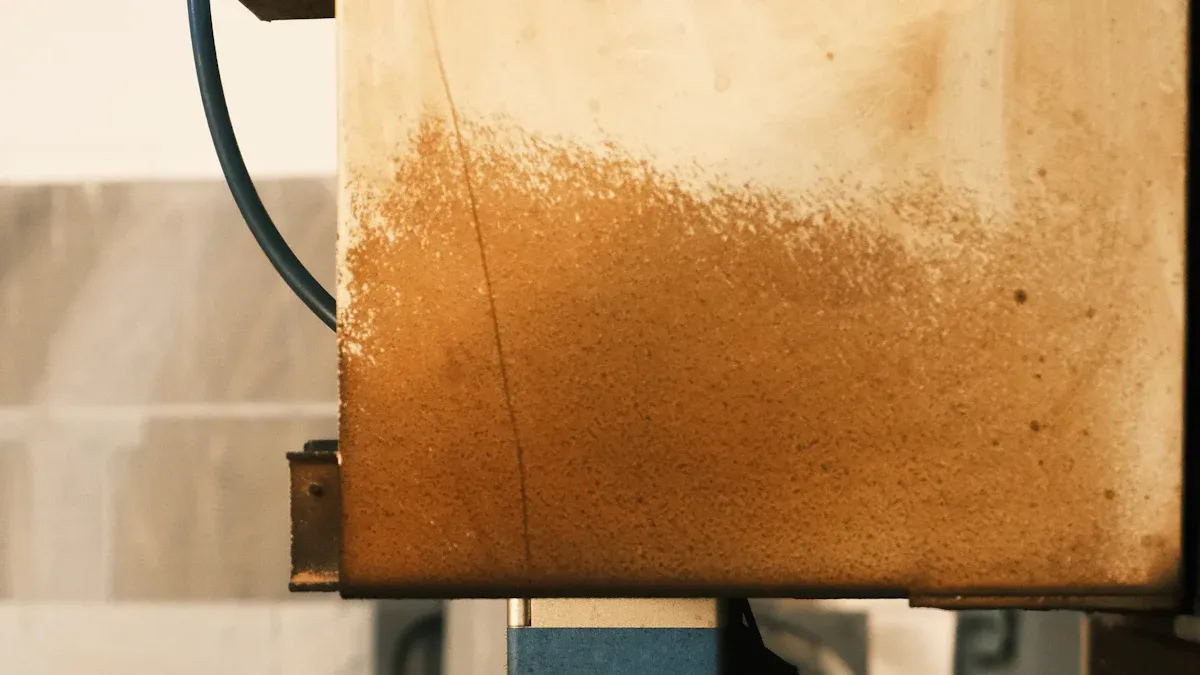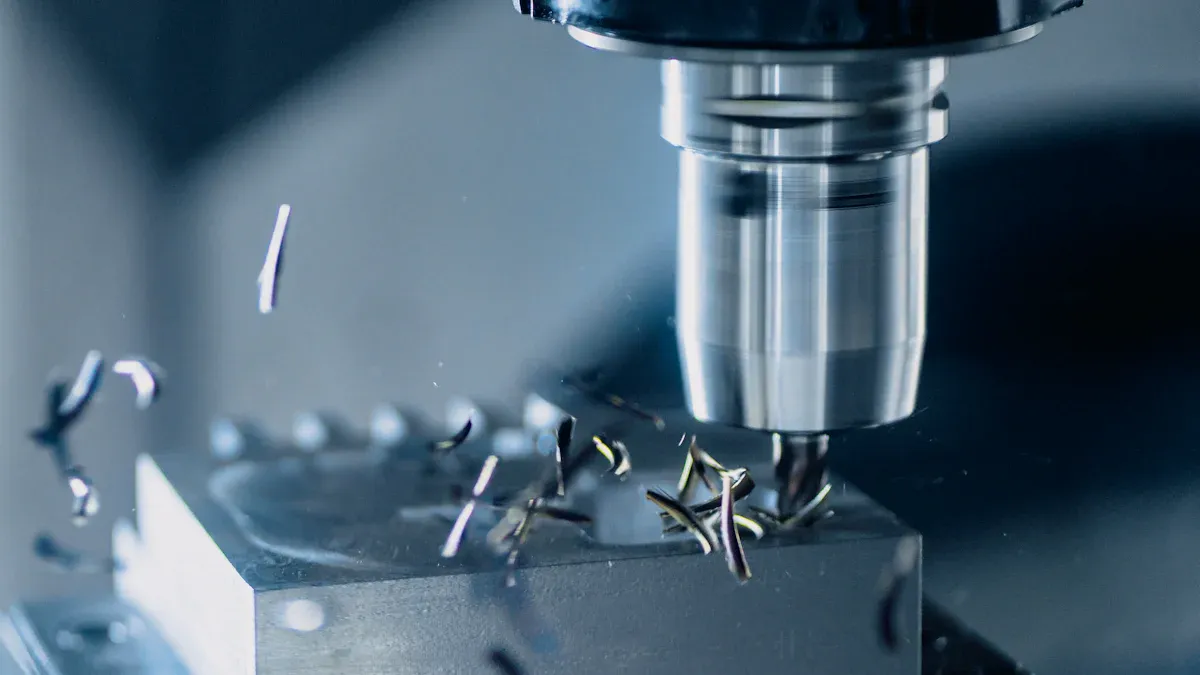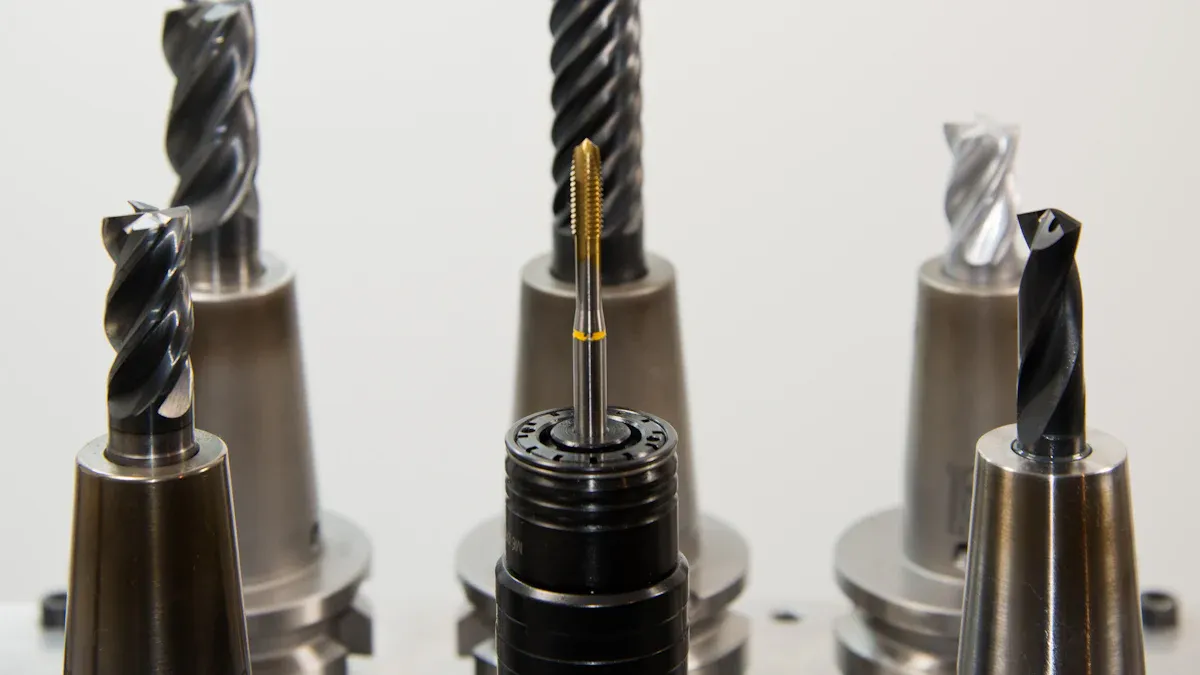Apr.
01, 2025
Contents
Common Materials Used in High-Precision Industrial Parts
Metals in High-Precision Industrial Parts
Non-Metals in High-Precision Industrial Parts
Composites for High-Precision Industrial Parts
Emerging Materials in High-Precision Industrial Parts
Key Factors in Picking Materials for Precise Industrial Parts

Choosing the right material is key for making high-precision industrial parts. The material you pick affects how strong and durable the part is. It also impacts how well it handles stress and wear over time. Every material has special traits like strength, flexibility, and toughness in tough conditions. Knowing these traits helps you make high-precision industrial parts that work well and save money.

Metals are very important for making precise industrial parts. They make up 70%-80% of these parts because of their great qualities. Metals are strong, hard, and resist wearing out. They also conduct electricity and heat well, making them perfect for structural and conductive uses.
Stainless steel is a common material for precise industrial parts. It is strong and does not rust, so it works well in tough conditions. You can find it in medical tools, airplane parts, and food machines. It stays strong even in very hot or cold temperatures, making it reliable for a long time.
Aluminum is light and does not rust easily. It is used in cars and airplanes where weight matters. Even though it is light, it is strong and lasts a long time. Aluminum conducts heat well, so it is great for cooling systems. It is also easy to shape, which lowers production costs.
Brass is soft, resists rust, and conducts heat and electricity well. Its softness helps make detailed shapes, like connectors. Brass does not rust, so it is good for plumbing and wet places. It is also great for moving heat and electricity in parts.
| Property | Description |
|---|---|
| Malleability | Brass is softer than bronze or zinc, making shaping easier. |
| Corrosion Resistance | It does not rust, so it works in harsh places. |
| Electrical Conductivity | It conducts electricity well, good for electrical parts. |
| Thermal Conductivity | It moves heat well, useful for heat-related uses. |
Brass is a strong and useful material for precise parts, especially when both strength and conductivity are needed.
Titanium is a great material for precise industrial parts. It is very strong but also lightweight. This makes it perfect for airplanes, medical tools, and defense equipment. Titanium does not rust, even in tough places like seawater or with strong chemicals.
Studies show AI has helped improve titanium alloy production. It allows making strong, high-quality titanium with custom features. This is important for industries like aerospace and defense, where strong and flexible materials are needed.
A popular titanium alloy, Ti-6Al-4V, is both strong and light. It is used in ships, planes, and medical implants. New AI technology has made titanium production better. Engineers can now make stronger, lighter parts faster. This saves time and keeps titanium’s great qualities.
Research shows AI has found new ways to make titanium alloys like Ti-6Al-4V. These methods allow quicker production without losing strength or quality.
Titanium is strong, light, and does not rust. These features make it a top choice for precise industrial parts. Its flexibility means it works well in many industries.
Carbon steel is another important material for precise parts. It is strong, hard, and easy to shape. This makes it useful for car gears, tools, and airplane parts.
Carbon steel is easier to shape than stainless steel.
It is hard and tough, good for cutting and grinding.
High-carbon steel resists wear, perfect for tools and tough jobs.
Heating carbon steel improves its strength and toughness. This lets you adjust it for different needs. For example, high-carbon steel is great for tools that face heavy use. It lasts a long time in tough conditions.
If you need a strong and affordable material, choose carbon steel. Its flexibility and strength make it a favorite for precise industrial parts.
Non-metals are important for making precise industrial parts. They are lightweight, resist rust, and handle heat well. These materials work where metals might not, like in electronics, planes, and medical tools.
Strong plastics like PEEK and PTFE are changing how parts are made. They can replace metals, saving weight and energy. These plastics handle heat and chemicals, making them great for cars and planes.
Property PEEK Ultem Heat Resistance Up to 500ºF Up to 340ºF Chemical Resistance Resists most chemicals Good, meets fire safety rules Mechanical Properties Strong, flexible, impact-resistant Good strength, impact-resistant Processing Capability Harder to machine Easier to machine Cost Expensive, high quality Cheaper option
PEEK is strong and resists impacts. PTFE is slippery and lasts long. These features make them good for seals, bearings, and insulators.
Handles high heat in tough places.
Resists chemicals in harsh settings.
Strong and flexible for precise uses.
Ceramics are another great choice for precise parts. They are very hard, resist wear, and handle high heat. This makes them perfect for cutting tools, implants, and electronics. Ceramics do not rust, so they last in tough places. They also insulate heat and electricity, making them useful in many industries.
Carbon materials like graphite are key in precision work. Graphite moves heat and electricity well, so it’s used in electronics, planes, and nuclear energy. Pure graphite is reliable and precise in tough jobs.
Property/Application Description Conductivity Moves heat and electricity well for precise uses. Purity Pure graphite works in electronics, planes, and nuclear energy. Isostatic Pressing Makes even, precise graphite for high-performance needs.
Carbon fibers are strong, stiff, and light. They are used in cars and planes. Graphene, a carbon type, is used in flexible electronics and batteries because it is strong and conducts well.
Tip: Carbon materials are also used in batteries, steelmaking, and lubricants. They are even used to make fake diamonds. Their many uses make them vital in modern engineering.

Composites mix two or more materials to make stronger products. These materials are important for precise parts because they are strong, durable, and light. Let’s look at some common composites.
CFRP is made by mixing carbon fibers with a plastic base. It is used in planes, cars, and sports gear. This material is very strong but also lightweight. It is perfect when reducing weight is important. CFRP does not rust and stays strong under heavy stress.
For example, CFRP is used in airplane wings and car frames. It helps save fuel by being light. Its stiffness keeps it working well in tough conditions. CFRP is great for parts needing strength and accuracy.
GFRP mixes glass fibers with a plastic base. It costs less than CFRP but is still strong and flexible. This composite works well in many settings. It is good for equipment that needs to be light but carry heavy loads.
Composite Type Benefits Application Example Glass Fiber Reinforcement Cheaper, strong, works in many places Used in building, wind turbines, and marine equipment
You’ll find GFRP in buildings, windmills, and boats. Its low cost and flexibility make it a favorite for precise parts.
MMC combines metal with ceramic or other strong materials. It is stronger, handles heat better, and lasts longer than regular metals. It is great for parts that face high heat or heavy use.
For example, MMC is used in engines and cutting tools. It lasts longer than metal alone and works well in tough jobs. Picking MMC improves the strength and accuracy of your parts.
Did you know? Ceramic matrix composites, a type of MMC, last 10 times longer than metals. They are used in steam crackers where heat is very high.
Composites like CFRP, GFRP, and MMC are changing how precise parts ar
New materials are changing how we make precise industrial parts. They are stronger, last longer, and adapt better. These features make them great for industries like airplanes, cars, and healthcare.
Advanced alloys are made to be strong and light. They are perfect for jobs needing tough and efficient materials. Airplane and car makers use them to save fuel and build strong structures.
Alloys with better strength and weight are in high demand.
New science has made them resist rust, lasting longer.
Light alloys use less energy, helping eco-friendly industries.
These alloys help create reliable and affordable precision parts.
Nanomaterials are tiny but powerful for industrial uses. Their small size gives them special abilities to improve parts. For example, nanocomposites make materials stronger and more flexible.
Special coatings make surfaces harder and resist chemicals.
Carbon nanotubes help in electronics by boosting electron flow.
Nanocomposites are strong, light, and last a long time.
Nanomaterials are key for industries needing precise and advanced parts.
Bio-compatible materials are vital for medical tools and implants. They are safe for humans and work well in tough conditions. Titanium and special plastics are used because they don’t rust or harm the body.
These materials lower the chance of bad reactions in people.
They stay strong and work well for a long time.
Being light makes them easy to use in complex systems.
Bio-compatible materials are opening new doors in healthcare. They provide safe and precise solutions for human needs.
Choosing the right material for precise parts needs careful thought. These factors help parts work well and meet their job needs.
A material's strength and flexibility decide how it handles stress. Think about things like how strong, hard, or bendable it is. For example, aluminum and titanium are strong but light, great for planes and cars. Stainless steel is tough and resists bending, perfect for heavy-duty jobs.
A study showed why strength matters in precise parts. It found that raising the heat during 3D printing made PEEK parts stronger. This proves that picking the right material and process improves part performance.
Parts in tough places need to handle heat and chemicals. Materials should stay strong in high heat or with harsh chemicals. Titanium fights rust and works in hot spots. PEEK plastic resists chemicals very well.
Picking the wrong material can cause big problems. Parts might bend, break, or fail in heat. A study found bad material choices lead to costly fixes or recalls. To avoid this, check how much heat and chemicals a material can handle.
Problem What Happens Weak Structure Parts bend or break, losing accuracy and strength. Poor Heat Resistance Parts warp or fail in high heat, hurting performance. Expensive Fixes Bad material choices mean spending more on repairs or redesigns.
Cost and supply decide if a material fits your project. Titanium and PEEK work well but cost more and are harder to find. Aluminum and brass are cheaper and easier to get, making them good for many uses.
Cost checks help you pick wisely. Compare costs from past projects to stay on budget. Look at price trends to plan for future expenses.
Cost Check Method What It Does Check Cost Data Makes sure costs are needed and fair. Predict Future Costs Uses past data to guess future prices. Compare Costs Matches current costs with past projects.
Balancing quality, cost, and supply ensures your parts work well and stay affordable.
When picking materials for precise parts, think about your industry. Each industry has special needs that affect material choices. These needs help parts work well and stay safe.
For example, airplanes need light materials like titanium and carbon fiber. These materials save fuel and handle extreme heat. In healthcare, bio-safe materials like PEEK and titanium are used. They are safe for the body and don’t rust in wet conditions.
You should check a few things before deciding. Cost is important because companies want to save money but keep quality. Materials that are easy to shape lower production time and costs. Strength, like how much stress a material can take, is also key. Rust resistance matters for parts in tough places like oceans or chemical plants.
Sometimes, improving one thing can make another worse. For example, making a material stronger might make it harder to shape. To handle this, you need to study the material carefully and use good data.
Here’s a quick look at industry needs:
Factor What It Means Cost Picking materials that are affordable but still good quality. Formability How easy it is to shape the material during production. Strength How well the material holds up under pressure or stress. Rust Resistance How well the material avoids damage from water or chemicals. Trade-offs Balancing one good feature without making another worse. Data Challenges Finding the right information from large material databases. Different Needs Each product or industry needs specific materials.
Knowing these needs helps you pick the best materials. This makes sure your parts are strong, safe, and last a long time.
Picking the right materials for precise parts makes them last longer. It also improves how well they work and saves money. Metals, plastics, and new materials each have special uses. Match the material's features to what your project needs. For instance, changing how layers are built can make parts better. Working with design teams helps pick materials that fit the job. Experts and smart tools make choosing easier and encourage new ideas.
Stainless steel is the top choice. It is strong, resists rust, and lasts long. It is used in industries like airplanes, healthcare, and food machines. It also handles very hot or cold temperatures, making it dependable.
Composites like CFRP and GFRP are strong and light. They lower weight but stay tough. This is why they are great for planes and cars. These industries need to save fuel and work efficiently.
Think about what your project needs. Check strength, heat resistance, and cost. Titanium is good for tough places, while PEEK plastic is light and resists chemicals. Match the material to the job it will do.
Some plastics like PEEK and PTFE are very tough. They resist heat, chemicals, and wear. They are not as strong as metals but are lighter and don’t rust. This makes them useful for certain jobs.
Nanomaterials make parts stronger, flexible, and long-lasting. Carbon nanotubes help electronics by improving electricity flow. Nanocomposites are light and strong, perfect for planes and cars. Their special features are great for advanced uses.
Navigation
Navigation
Contact Us
Tel: +86 13417419143
E-mail: [email protected]
Add:
2nd Floor, Building 7, 156 High Tech Industrial Park, Fuyuan 1st Road, Zhancheng Community, Fuhai Street, Baoan District, Shenzhen City, China.